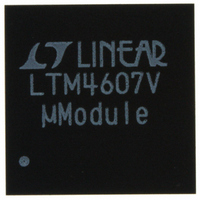LTM4607EV#PBF Linear Technology, LTM4607EV#PBF Datasheet - Page 11

LTM4607EV#PBF
Manufacturer Part Number
LTM4607EV#PBF
Description
IC BUCK/BOOST SYNC ADJ 5A 141LGA
Manufacturer
Linear Technology
Series
µModuler
Type
Point of Load (POL) Non-Isolatedr
Datasheet
1.LTM4607EVPBF.pdf
(26 pages)
Specifications of LTM4607EV#PBF
Design Resources
LTM4607 Spice Model
Output
0.8 ~ 24 V
Number Of Outputs
1
Power (watts)
120W
Mounting Type
Surface Mount
Voltage - Input
4.5 ~ 36 V
Package / Case
141-LGA
1st Output
0.8 ~ 24 VDC @ 5A
Size / Dimension
0.59" L x 0.59" W x 0.11" H (15mm x 15mm x 2.8mm)
Power (watts) - Rated
120W
Operating Temperature
-40°C ~ 85°C
Efficiency
98%
Lead Free Status / RoHS Status
Lead free / RoHS Compliant
3rd Output
-
2nd Output
-
Available stocks
Company
Part Number
Manufacturer
Quantity
Price
APPLICATIONS INFORMATION
or choose a capacitor rated at a higher temperature than
required. Always contact the capacitor manufacturer for
derating requirements.
Output Capacitors
In boost mode, the discontinuous current shifts from the
input to the output, so the output capacitor C
capable of reducing the output voltage ripple.
For boost and buck modes, the steady ripple due to charg-
ing and discharging the bulk capacitance is given by:
The steady ripple due to the voltage drop across the ESR
(effective series resistance) is given by:
The LTM4607 is designed for low output voltage ripple.
The bulk output capacitors defined as C
with low enough ESR to meet the output voltage ripple and
transient requirements. C
capacitor, the low ESR polymer capacitor or the ceramic
capacitor. Multiple capacitors can be placed in parallel to
meet the ESR and RMS current handling requirements.
The typical capacitance is 300μF . Additional output filtering
may be required by the system designer, if further reduc-
tion of output ripple or dynamic transient spike is required.
Table 3 shows a matrix of different output voltages and
output capacitors to minimize the voltage droop and
overshoot at a current transient.
Inductor Selection
The inductor is chiefly decided by the required ripple cur-
rent and the operating frequency. The inductor current
ripple ΔI
V
V
V
V
RIPPLE,BUCK
ESR,BUCK
ESR,BOOST
RIPPLE,BOOST
L
is typically set to 20% to 40% of the maximum
= ΔI
= I
=
L(MAX)
=
L(MAX)
8 • L • C
V
I
OUT(MAX)
OUT
• ESR
OUT
• ESR
• V
OUT
C
(
OUT
IN(MAX)
can be the low ESR tantalum
• V
• V
(
• V
IN(MAX)
OUT
OUT
− V
− V
OUT
• ƒ
OUT
• ƒ
IN(MIN)
)
2
OUT
are chosen
)
must be
inductor current. In the inductor design, the worst cases
in continuous mode are considered as follows:
where:
The inductor should have low DC resistance to reduce the
I
current without saturation. To minimize radiated noise,
use a toroid, pot core or shielded bobbin inductor. Please
refer to Table 3 for the recommended inductors for dif-
ferent cases.
R
R
Since the maximum inductor valley current at buck mode
is much lower than the inductor peak current at boost
mode, different sensing resistors are suggested for use
in buck and boost modes.
The current comparator threshold sets the peak of the
inductor current in boost mode and the maximum inductor
valley current in buck mode. In boost mode, the allowed
maximum average load current is:
where ΔI
2
SENSE
SENSE
R losses, and must be able to handle the peak inductor
ƒ is operating frequency, Hz
Ripple% is allowable inductor current ripple, %
V
V
V
I
I
L
L
OUT(MAX)
OUT(MAX,BOOST)
OUT(MAX)
IN(MAX)
OUT
BOOST
BUCK
is chosen based on the required inductor current.
Selection and Maximum Output Current
is output voltage, V
L
≥
is peak-to-peak inductor ripple current.
≥
is maximum input voltage, V
V
is maximum output load current, A
V
IN(MAX)
is maximum output voltage, V
OUT(MAX)
V
OUT
V
=
IN
• ƒ • I
⎛
⎜
⎝
• V
R
160mV
• V
(
• ƒ • I
(
SENSE
IN(MAX)
OUT(MAX)
OUT(MAX)
OUT(MAX)
−
− V
ΔI
2
L
• Ripple%
− V
OUT
⎞
⎟ •
⎠
LTM4607
• Ripple%
IN
)
V
)
V
OUT
IN
11
4607fb















